Chapter Introduction
30-1
30-2
30-3
CHAPTER 30
AGRICULTURE: RAISING LIVESTOCK
A CARNIVORE’S CONUNDRUM
Disease, pollution, and the true costs of meat

CORE MESSAGE
Affluence affects diet, increasing the demand for animal food products. Current approaches to rearing livestock in an industrial setting produce a lot of affordable meat and dairy products but also produce negative health and environmental impacts. While meat and dairy products can be part of the solution to feeding the world, the trade-offs associated with current industrial practices are making many rethink the environmental and ethical soundness of these methods.
AFTER READING THIS CHAPTER, YOU SHOULD BE ABLE TO ANSWER THE FOLLOWING GUIDING QUESTIONS
1 What food safety issues are associated with meat products like beef? How does affluence affect diet and health?
2 How are concentrated animal feeding operations (CAFOs) used to rear animals for food, and what are the pros and cons of this method?
3 How can animals be sustainably reared? Will sustainable methods address the disadvantages of CAFOs and be as productive?
4 How can agricultural policies address food supply and safety issues?
5 What are the benefits of eating lower on the food chain or eating smaller servings of products from animals reared on grasslands?
30-4
On July 5, 2007, an 18-year-old girl in central Pennsylvania fell suddenly and violently ill: diarrhea, abdominal cramps, vomiting. Three days later, a New Jersey man developed the same constellation of symptoms, and in mid-August, so did a 15-year-old girl in Pembroke Pines, Florida. The Florida case was the worst of the three; the patient was hospitalized with a rare form of kidney failure and would need several rounds of dialysis before recovering. Still, those cases might have gone unnoticed by health officials and by the public at large were it not for what happened next.
On September 7, when an Albany man also fell ill, epidemiologists working for the New York State Health Department analyzed a hamburger patty recovered from his refrigerator and found that it contained a particularly virulent strain of the bacterium E. coli—a strain known as O157:H7.